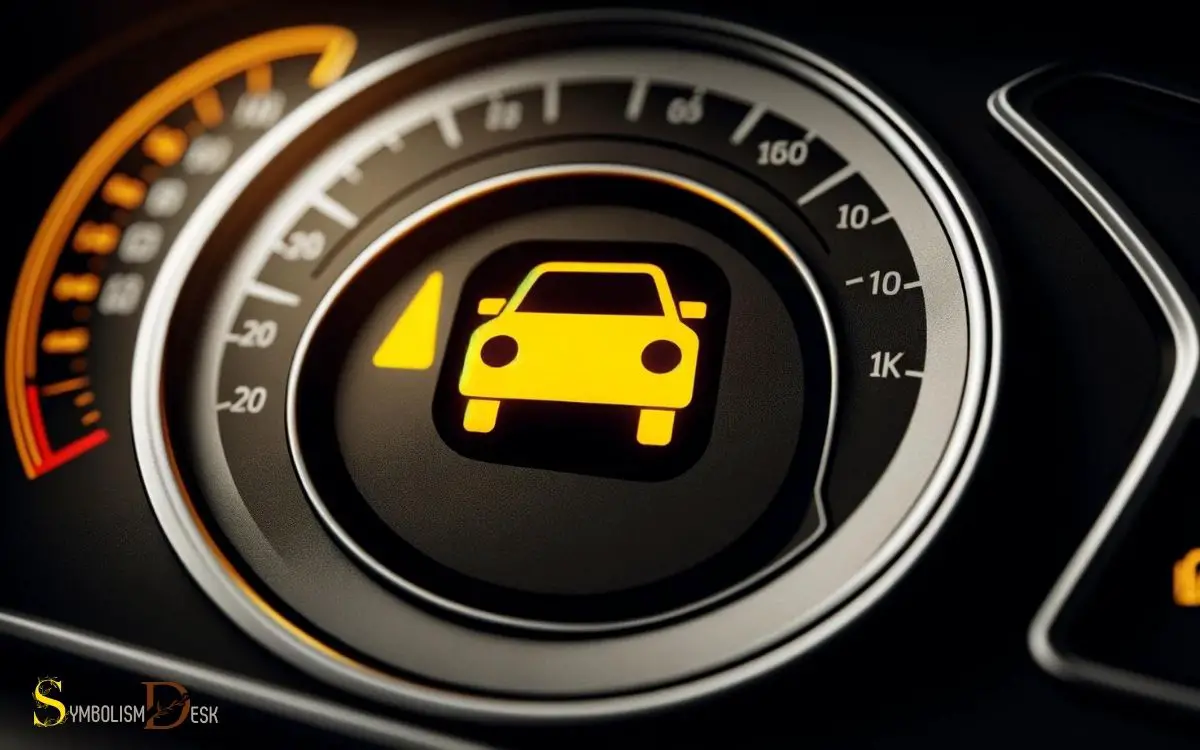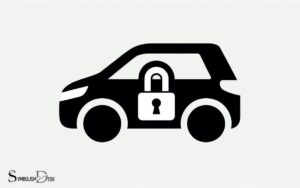Yellow Car Symbol on Dashboard: Explain!
The yellow car symbol on your dashboard, often accompanied by an exclamation mark, is typically the “Vehicle Stability Control” (VSC) warning light.
It indicates that the VSC system is engaged, which helps stabilize the car when it detects a loss of traction during cornering or sudden maneuvers.
However, it could also represent other issues depending on its design and the make and model of your vehicle.
When you see a yellow car symbol on your dashboard, it’s important to understand what it represents to ensure your safety and the smooth operation of your vehicle.
This symbol can vary in its meaning based on the car’s manufacturer, but a few common interpretations include:
- Vehicle Stability Control (VSC) Active: This indicates that the VSC system is actively working to maintain vehicle stability.
- Traction Control System (TCS) Warning: When traction is lost, this system activates to prevent wheel spin.
- Vehicle Dynamics Control (VDC) Warning: Similar to VSC, it’s found in some makes of vehicles and indicates the system is functioning to maintain stability.
The specific design of the symbol can give you more clues about what your car is trying to communicate:
- A car with squiggly lines beneath it typically refers to the VSC or TCS.
- A car with a wrench or spanner indicates a maintenance issue or scheduled service.
- A car with an exclamation mark can indicate a range of issues, including tire pressure warnings or a general fault with the vehicle’s electronic systems.
If you’re ever unsure about the meaning of a warning light, consult your vehicle’s owner manual as it will provide the most accurate information for your specific car model.

Key Takeaway
Common Causes of Yellow Car Symbol
The yellow car symbol on the dashboard typically indicates a potential issue with the vehicle that requires attention. One common cause of this warning light is a problem with the engine, such as a misfiring engine, which can lead to catalytic converter damage if not addressed promptly.
Another frequent reason for the yellow car symbol is a faulty oxygen sensor. This can negatively impact fuel economy and cause the vehicle to run less efficiently.
Additionally, a loose gas cap may trigger the light, signaling an issue with the evaporative emissions system. It’s important to address these potential problems promptly to prevent further damage and maintain the vehicle’s performance.
If this warning light appears, it’s advisable to consult a mechanic for a thorough inspection and necessary repairs.
Understanding the Yellow Car Symbol
Upon encountering the yellow car symbol on the dashboard, drivers should understand its significance and potential implications to ensure prompt action is taken.
If ignored, the issues related to this warning light can lead to further complications and potential damage to the vehicle.
| Symbol | Meaning |
|---|---|
| Yellow Car Symbol | Indicates a problem with the engine or transmission that requires attention. |
The yellow car symbol typically indicates a problem with the engine or transmission. It is crucial to address this warning promptly to prevent further damage and maintain the vehicle’s performance. Ignoring the warning could lead to more severe issues, such as reduced fuel efficiency or costly repairs down the line. Understanding the yellow symbol meaning in cars can help drivers take the necessary steps, like consulting the owner’s manual or seeking professional assistance. Regular maintenance and timely action are essential to ensure the safety and longevity of your vehicle.
Understanding the potential issues associated with this symbol empowers drivers to take appropriate action, whether it involves seeking professional assistance or performing necessary maintenance.
Ignoring this warning light can result in costly repairs and safety hazards. Therefore, it is essential to address the underlying problem as soon as possible to ensure the vehicle’s reliability and safety on the road.
Importance of Addressing the Warning
Addressing the yellow car symbol on the dashboard is crucial because it indicates a potential issue with the vehicle.
Ignoring the warning may lead to further damage or costly repairs down the line. Therefore, it is important to seek a professional diagnosis to address the underlying problem promptly.
Warning Indicates Potential Issue
When encountering the yellow car symbol on the dashboard, drivers should not ignore or delay addressing the potential issue it indicates. Ignoring the warning could lead to more severe damage to the vehicle or even pose a safety risk.
To better understand the potential issue, drivers should consider the following:
- Check the owner’s manual to identify the specific problem associated with the yellow car symbol.
- This will help drivers understand the urgency of addressing the issue and the potential consequences of ignoring it.
- Inspect the vehicle for any visible signs of the problem, such as leaks or unusual sounds.
- Identifying visible signs can provide additional information when seeking assistance from a mechanic.
- Schedule an appointment with a qualified mechanic to diagnose and repair the issue promptly.
- Addressing the warning promptly can prevent further damage and ensure the vehicle’s safety and reliability.
Ignoring May Cause Damage
The yellow car symbol on the dashboard signals a potential issue that should not be disregarded. Ignoring this warning could lead to severe damage to the vehicle and compromise the safety of the driver and passengers.
Addressing the underlying problem promptly can prevent costly repairs and ensure the vehicle continues to operate smoothly. It is crucial to take the necessary steps to investigate the cause of the warning symbol and take appropriate action to resolve the issue.
| Potential Issue | Consequences | Action Needed |
|---|---|---|
| Low tire pressure | Increased risk of blowout | Check and inflate tires |
| Engine overheating | Engine damage, potential breakdown | Pull over, let the engine cool down, check coolant level |
| Brake system malfunction | Reduced braking ability, potential accidents | Have the brake system inspected and repaired |
Seek Professional Diagnosis
Promptly seeking professional diagnosis is crucial in ensuring the yellow car symbol on the dashboard is thoroughly understood and addressed.
When seeking professional diagnosis, individuals can expect the following:
- Clear Explanation: A trained professional can provide a clear explanation of the issue indicated by the yellow car symbol, offering insight into the potential causes and necessary actions.
- Accurate Assessment: Through diagnostic tools and expertise, a professional can accurately assess the specific issue, determining the severity and urgency of the problem.
- Proper Resolution: Seeking professional diagnosis can lead to the proper resolution of the underlying problem, preventing potential damage and ensuring the vehicle operates safely.
Potential Impact on Vehicle Performance
The yellow car symbol on the dashboard’s appearance may signal potential impacts on the vehicle’s performance. When this light illuminates, it could indicate issues with the engine, transmission, or other critical components.
Ignoring this warning could lead to reduced fuel efficiency, decreased power, or even complete breakdown. The vehicle’s onboard computer system constantly monitors various sensors, and when it detects a problem that could affect performance, it triggers the yellow car symbol.
Addressing the underlying issue promptly is crucial to prevent further damage and maintain optimal performance.
Therefore, it’s essential to seek professional diagnosis and necessary repairs to ensure the vehicle operates at its best and to avoid potential safety hazards on the road.
Steps to Identify the Issue
One common way to identify the issue indicated by the yellow car symbol on the dashboard is to use an OBD-II scanner. This diagnostic tool plugs into a port usually located under the dashboard and provides specific error codes related to the vehicle’s systems.
To identify the issue:
- First, locate the OBD-II port under the dashboard. It is often found near the driver’s side.
- Next, plug the OBD-II scanner into the port until it clicks into place.
- Turn the vehicle’s ignition to the accessory position, but do not start the engine. This allows the scanner to communicate with the car’s computer and retrieve the error codes.
Using an OBD-II scanner can help car owners pinpoint the specific issue indicated by the yellow car symbol, providing valuable information for addressing the problem.
Resolving Yellow Car Symbol Warnings
When the yellow car symbol appears on the dashboard, it is important to promptly address the issue to ensure the vehicle’s optimal performance and safety.
The first step is to consult the owner’s manual to understand the specific warning indicated by the symbol. This can provide valuable insights into potential issues that need attention.
If the warning is related to the engine, it is advisable to schedule a diagnostic check with a qualified mechanic to identify the root cause.
For issues related to the brake system or airbags, seeking professional assistance is crucial to ensure the safety features are functioning properly. Ignoring these warnings may lead to further damage and compromise safety.
Therefore, it’s essential to address yellow car symbol warnings promptly and thoroughly to maintain the vehicle’s reliability and safety.
Maintenance Tips for Preventing Recurrence
To prevent the recurrence of yellow car symbol warnings, regularly inspecting the vehicle’s systems and addressing any potential issues promptly is essential for maintaining optimal performance and safety.
This can be achieved by following these maintenance tips:
- Regular Fluid Checks: Ensure that oil, coolant, brake fluid, and other essential fluids are at the appropriate levels and in good condition.
- Scheduled Maintenance: Adhere to the manufacturer’s recommended maintenance schedule for services such as oil changes, filter replacements, and tune-ups.
- Diagnostic Scans: Utilize diagnostic scans to identify any underlying issues with the vehicle’s electronic systems, engine, or other components.
Orange Symbol on Car Dashboard
The meaning of an orange symbol on a car dashboard can vary depending on the make and model of the car, as well as the specific symbol that is illuminated.
However, here are some common orange symbols you might encounter on a car dashboard and their general meanings:
- Check Engine Light: This is one of the most common orange warning lights. It indicates that there is an issue with the engine or the vehicle’s emissions system. It could be a minor problem, such as a loose gas cap, or a more serious issue that requires immediate attention.
- Tire Pressure Warning Light: This light typically looks like an exclamation point inside a horseshoe or a tire symbol. It means that one or more of your tires have low pressure, which can affect handling and fuel efficiency.
- Battery Light: This symbol, often resembling a battery or a stylized “BATT,” warns you that there is an issue with your vehicle’s charging system. It could be a problem with the battery, alternator, or related components.
- Brake Warning Light: An orange brake symbol could indicate several things, such as low brake fluid, worn brake pads, or a problem with the brake system. It’s important to have your brakes inspected if this light comes on.
- ABS (Anti-lock Braking System) Light: If you see the letters “ABS” inside a circle or the ABS symbol, it means there is an issue with your vehicle’s anti-lock braking system. While your regular brakes may still work, the ABS system might be disabled.
- Transmission Temperature Warning Light: This symbol looks like a thermometer or an “AT” and warns you that the transmission is overheating. You should pull over and allow the transmission to cool down if this light comes on.
- Power Steering Warning Light: This symbol, often resembling a steering wheel with an exclamation point, indicates a problem with your power steering system. It can make steering more difficult, so it’s important to address the issue.
- Oil Pressure Warning Light: An orange oil can symbol indicates low oil pressure. If this light comes on, it’s crucial to check your oil level and address any potential oil leaks or engine issues promptly.
- Electronic Stability Control (ESC) or Traction Control System (TCS) Light: These symbols indicate a problem with your vehicle’s stability or traction control systems. It could affect your ability to maintain control of the vehicle in slippery conditions.
- Airbag Warning Light: This symbol typically looks like a person with an airbag deployed in front of them. It indicates a problem with your vehicle’s airbag system, which can affect safety in the event of a collision.
These are just a few examples of orange warning symbols you might encounter on a car dashboard.
Conclusion
Addressing the yellow car symbol on the dashboard is crucial for maintaining vehicle performance. Ignoring the warning could have a catastrophic impact on the car’s functionality.
By understanding the causes and taking proactive maintenance steps, drivers can prevent potential issues and keep their vehicles running smoothly. Remember, a little caution goes a long way in ensuring the longevity of your car.






